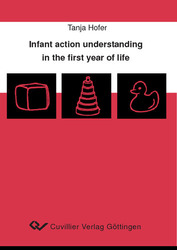| Departments | |
|---|---|
| Book Series (96) |
1378
|
| Nachhaltigkeit |
3
|
| Gesundheitswesen |
1
|
| Humanities |
2364
|
| Medienwissenschaften | 16 |
| Theology | 57 |
| Philosophy | 102 |
| Law | 422 |
| Economics | 850 |
| Social sciences | 416 |
| Sports science | 48 |
| Psychology | 233 |
| Educational science | 190 |
| History | 182 |
| Art | 111 |
| Cultural studies | 166 |
| Literary studies | 116 |
| Linguistics | 88 |
| Natural Sciences |
5406
|
| Engineering |
1793
|
| Common |
98
|
|
Leitlinien Unfallchirurgie
5. Auflage bestellen |
|
Advanced Search
Infant action understanding in the first year of life (English shop)
Tanja Hofer (Author)Preview
Table of Contents, Datei (96 KB)
Extract, Datei (140 KB)
Understanding and interpreting the actions and minds of other people is one of the most challenging tasks for infants and young children in their development. To reason about other’s actions in terms of goals forms an important cornerstone in infants’ action understanding. Understanding actions as goal-directed enables the interpretation, prediction and the making of further sense of other people’s actions and behaviour. This ability to detect that an action is directed toward a goal has been theorised to be among the first elements present in infants’ reasoning about people’s behaviour, preceding an understanding of intentions and other mental states (Dennett, 1987; Premack, 1990; Wellman, 1992). However, to become a functional member of our world and achieve an adult-like understanding of others’ actions and minds, infants have a long way to go.
| ISBN-13 (Printausgabe) | 3865375545 |
| ISBN-13 (Hard Copy) | 9783865375544 |
| ISBN-13 (eBook) | 9783736915541 |
| Language | German |
| Page Number | 162 |
| Edition | 1 |
| Volume | 0 |
| Publication Place | Göttingen |
| Place of Dissertation | Göttingen |
| Publication Date | 2005-08-15 |
| General Categorization | Dissertation |
| Departments |
Psychology
|








